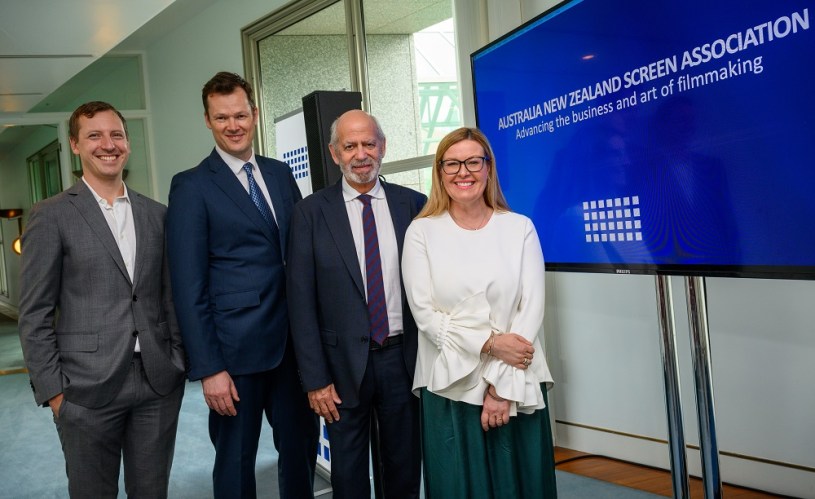(L-R) Matchbox Pictures’ Matt Vitins, Paul Muller, Jonathan Olsberg and Disney MD Kylie Watson-Wheeler release the report in Canberra.
The Australian screen sector has overcome digital disruption to post strong growth over five years, with overall economic output climbing by 13 per cent to $22.5 billion.
That’s according to a new report commissioned by the Australia New Zealand Screen Association (ANZSA), which tracked the sector in the five years to 2017/18.
“This growth is a strong example of the industry’s quick and efficient response to the digital disruption,” said Jonathan Olsberg, chairman of the report’s author Olsberg SPI.
“After a painful period of adjustment, the Australian screen industry is now well-positioned to take advantage of new opportunities on a global stage. It now has a more streamlined distribution model and greater ‘value add’ – and this has real economic benefits for consumers, who can now access more great Australian and international content for less than ever before.”
Despite the overall sector growth, the total screen production spend in that period shrank by an average of 0.4 per cent per year while the UK grew by 13.6 per cent, driven by footloose productions.
The film production spend dropped by 53 per cent from the 2016-17 level primarily due to the removal of the Federal Government’s discretionary ‘top-up’ program for international location shoots. However it recovered in 2018-19 with a flurry of activity triggered by the new Location Incentive.
Matchbox Pictures chief operating officer Matt Vitins said the location grants and incentives offered by Federal and State Governments are critical to maintaining Australia’s attractiveness when investors considered where to make their next productions.
Pointing to big budget series such as the Netflix-commissioned Clickbait, Vitins said: “The location incentive has been essential to us setting up international television projects in Australia. The extension or expiry of the scheme will have a big role to play in whether or not we see more premium international drama shoot here.”
ANZSA CEO Paul Muller said: “Our industry has always punched above its weight in the global arena, and after some tough adjustments, it’s exciting to see Australian consumers and producers benefiting from the opportunities of digitisation.
“Given how small the population of Australia is relative to the rest of the world, the sector is well positioned to increase foreign investment in Australian stories, provided government incentives are competitive with those offered by countries such as the UK and New Zealand, or US states such as Georgia and New York.”
In 2017-18, the Australian screen industries generated a total output of $22.5 billion, with $9.19 billion in Gross Value Added (GVA) and 84,982 total full-time (FTE) jobs.
The TV broadcast sector was the key driver of this success, delivering $10.82 billion, $4.87 billion in GVA and 22,987 FTE.
Production output was $4.57 billion and $1.63 billion GVA and 26,570 FTE.
Distribution output was $2.43 billion with $872 million GVA and 14,144 FTE.
Film exhibition also had a good year, generating $1.92 billion and 11,137 FTE.
The report predicts a 10 per cent increase in the screen sectors’ output in 2021-22 due to rising VOD revenues, the continuing strength of exhibition and anticipated growth in broadcasting.
While distribution revenue is expected to continue falling to 2021-22 it will return to growth in the next few years as the impacts of digitisation are fully realised.
View an infographic summary of the findings here.


